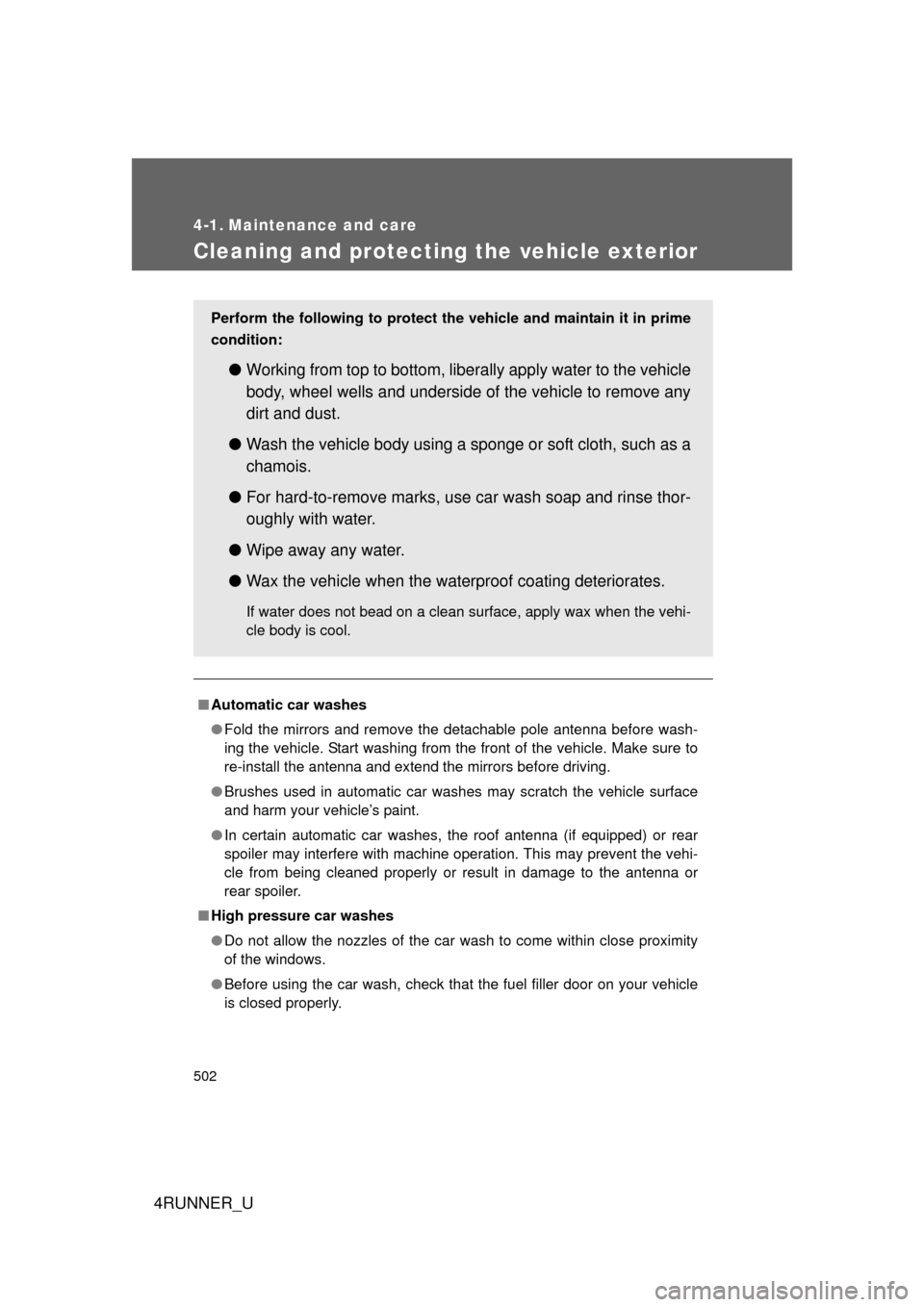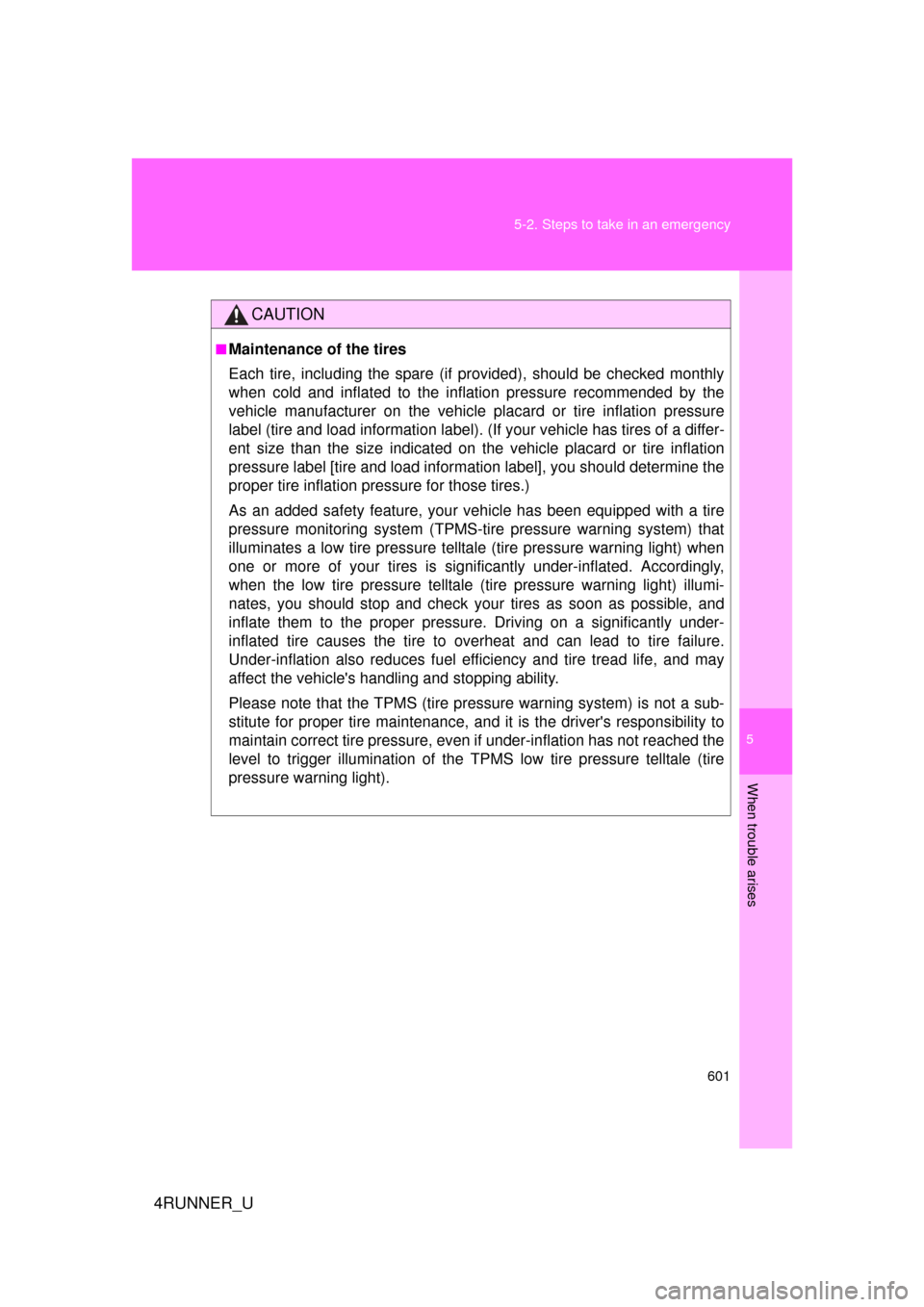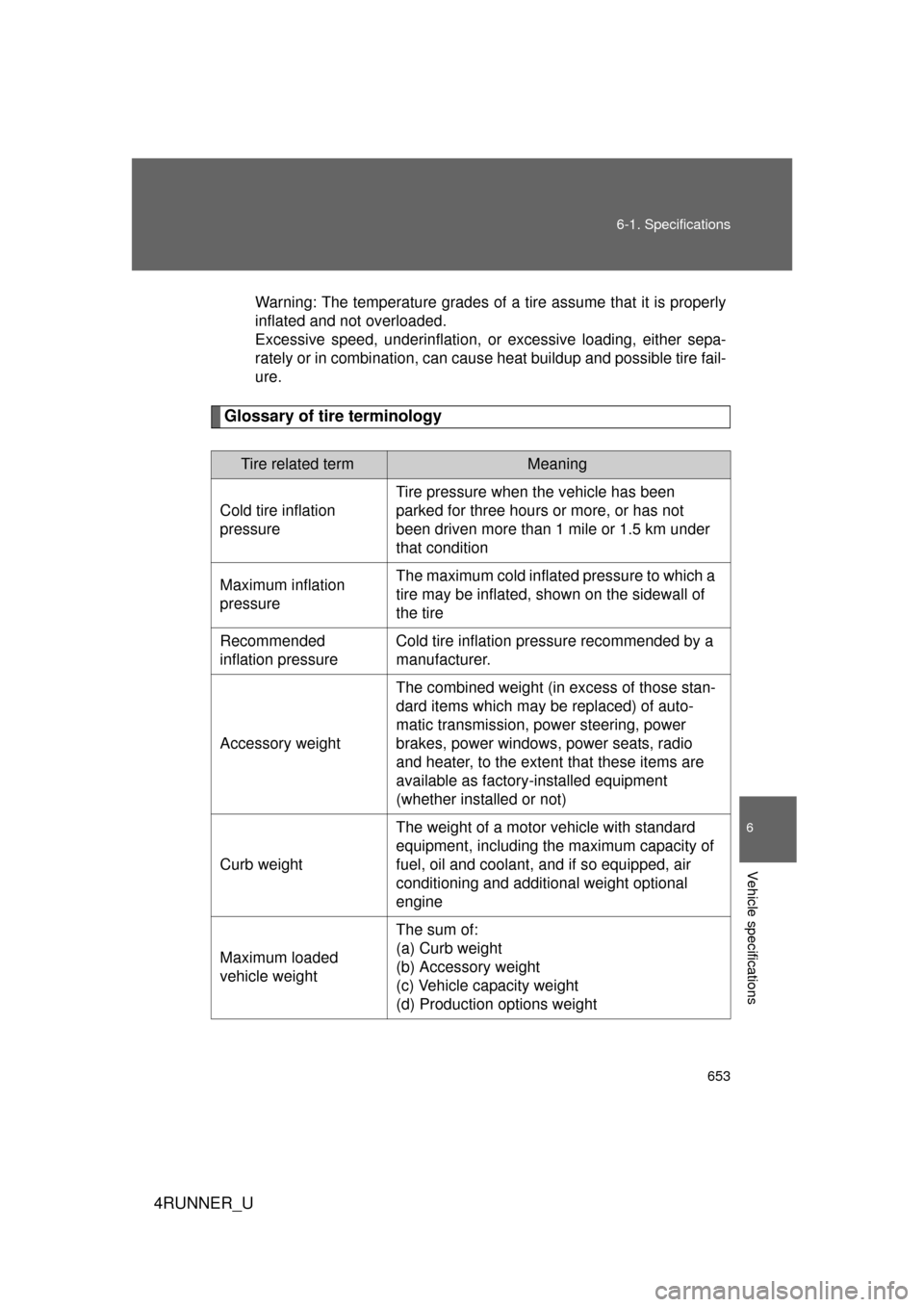2012 TOYOTA 4RUNNER fuel pressure
[x] Cancel search: fuel pressurePage 5 of 700

1
2
3
4
5
6
7
4RUNNER_U
5
4-1. Maintenance and careCleaning and protecting the vehicle exterior............ 502
Cleaning and protecting the vehicle interior............. 505
4-2. Maintenance Maintenance requirements ..................... 508
General maintenance.......... 511
Emission inspection and maintenance (I/M)
programs........................... 515
4-3. Do-it-yourself maintenance Do-it-yourself service precautions ....................... 516
Hood ................................... 519
Engine compartment ........... 520
Tires .................................... 537
Tire inflation pressure ......... 543
Wheels ................................ 547
Air conditioning filter............ 550
Wireless remote control/ electronic key battery ........ 552
Checking and replacing fuses ................................. 555
Light bulbs........................... 565 5-1. Essential information
Emergency flashers............ 578
If your vehicle needs to be towed........................... 579
If you think something is wrong ............................... 585
Fuel pump shut off system .............................. 586
5-2. Steps to take in an emergency
If a warning light turns on or a warning buzzer
sounds.............................. 587
If you have a flat tire ........... 603
If the engine will not start.... 616
If the shift lever cannot be shifted from P .............. 618
If you lose your keys........... 619
If you cannot operate back door opener ............. 620
If the electronic key does not operate properly ......... 621
If the vehicle battery is discharged........................ 623
If your vehicle overheats .... 627
If the vehicle becomes stuck ................................. 630
If your vehicle has to be stopped in an
emergency ....................... 631
4Maintenance and care5When trouble arises
Page 9 of 700

4RUNNER_U
9
: If equipped
*1: For vehicles with a navigation system, refer to the “Navigation System Owner’s Manual”.
*2: For vehicles with a Display Audio system, refer to “Display Audio System Owner’s Manual”.
Tires
●Rotation
● Replacement
● Inflation pressure
● Information
P. 537
P. 603
P. 643
P. 648
Rear window defogger P. 328
Rear window wiper
P. 214Side doors P. 53
Rear turn signal lights P. 183
License plate lights
P. 203
Back door P. 63
Stop/tail and rear side
marker lights
P. 203
Fuel filler door P. 109
Camera ,*1,*2
Page 502 of 700

502
4RUNNER_U
4-1. Maintenance and care
Cleaning and protecting the vehicle exterior
■Automatic car washes
● Fold the mirrors and remove the detachable pole antenna before wash-
ing the vehicle. Start washing from the front of the vehicle. Make sure to
re-install the antenna and extend the mirrors before driving.
● Brushes used in automatic car washes may scratch the vehicle surface
and harm your vehicle’s paint.
● In certain automatic car washes, the roof antenna (if equipped) or rear
spoiler may interfere with machine operation. This may prevent the vehi-
cle from being cleaned properly or result in damage to the antenna or
rear spoiler.
■ High pressure car washes
● Do not allow the nozzles of the car wash to come within close proximity
of the windows.
● Before using the car wash, check that the fuel filler door on your vehicle
is closed properly.
Perform the following to protect the vehicle and maintain it in prime
condition:
● Working from top to bottom, liber ally apply water to the vehicle
body, wheel wells and underside of the vehicle to remove any
dirt and dust.
● Wash the vehicle body using a sponge or soft cloth, such as a
chamois.
● For hard-to-remove marks, use car wash soap and rinse thor-
oughly with water.
● Wipe away any water.
● Wax the vehicle when the waterproof coating deteriorates.
If water does not bead on a clean surface, apply wax when the vehi-
cle body is cool.
Page 545 of 700

545
4-3. Do-it-yourself maintenance
4
Maintenance and care
4RUNNER_U
■Effects of incorrect tire inflation pressure
Driving with incorrect ti
re inflation pressure ma y result in the following:
●Reduced fuel efficiency
●Reduced driving comfort and tire life
●Reduced safety
●Damage to the drive train
If a tire needs frequent inflating, have it checked by your Toyota dealer.
■Instructions for checking tire inflation pressure
When checking tire inflation pressure, observe the following:
●Check only when the tires are cold.
If your vehicle has been parked for at least 3 hours or has not been
driven for more than 1 mile or 1.5 km, you will get an accurate cold
tire inflation pressure reading.
●Always use a tire pressure gauge.
The appearance of the tire can be mi sleading. In addition, tire infla-
tion pressure that is even just a few pounds off can affect ride quality
and handling.
●Do not reduce tire inflation pressure after driving. It is normal for tire
inflation pressure to be higher after driving.
●Never exceed the vehicle capacity weight.
Passengers and luggage weight should be placed so that the vehicle
is balanced.
Page 562 of 700

562 4-3. Do-it-yourself maintenance
4RUNNER_U■
Driver’s side instrument panel
FuseAmpereCircuit
1TA I L10 A Stop/tail lights
2PA N E L7.5 A Instrument panel lights
3GAUGE7.5 A Meter and gauge
4IGN10 A Multiport fuel injection system/
sequential multiport fuel injec-
tion system, air bag system,
smart key system
5WASHER20 A Wiper and washer
6WIP30 A Wiper and washer
7S/ROOF 25 A Electric moon roof
8DOOR RR25 A Power windows
9DOOR D25 A Power windows
10DOOR BACK30 A
Multiplex communication sys-
tem
11DOOR P30 A Power windows
12P/SEAT FR 30 A Front passenger's power seat
13S/HTR FR 20 A Seat heater system
14ECU-IG NO.210 AAir conditioning system, multi-
port fuel injection system/
sequential multiport fuel injec-
tion system
15IG17.5 A
Turn signal lights, emergency
flashers
16ECU-IG NO.110 AVehicle stability control sys-
tem, tire pressure warning sys-
tem, steering sensor
17DOOR7.5 A Power windows
Page 601 of 700

5
When trouble arises
601
5-2. Steps to take in an emergency
4RUNNER_U
CAUTION
■Maintenance of the tires
Each tire, including the spare (if provided), should be checked monthly
when cold and inflated to the inflation pressure recommended by the
vehicle manufacturer on the vehicle
placard or tire inflation pressure
label (tire and load information label). (If your vehicle has tires of a differ-
ent size than the size indicated on the vehicle placard or tire inflation
pressure label [tire and load information label], you should determine the
proper tire inflation pr essure for those tires.)
As an added safety feature, your vehicle has been equipped with a tire
pressure monitoring system (TPMS-ti re pressure warning system) that
illuminates a low tire pressure telltal e (tire pressure warning light) when
one or more of your tires is significantly under-inflated. Accordingly,
when the low tire pressure telltale (tire pre ssure warning light) illumi-
nates, you should stop and check your tires as soon as possible, and
inflate them to the proper pressure. Driving on a significantly under-
inflated tire causes the tire to overheat and can lead to tire failure.
Under-inflation also reduces fuel effi ciency and tire tread life, and may
affect the vehicle's hand ling and stopping ability.
Please note that the TPMS (tire pressure warning system) is not a sub-
stitute for proper ti re maintenance, an d it is the driver's responsibility to
maintain correct tire pressure, even if under-inflation has not reached the
level to trigger illu mination of the TPMS low tire pressure telltale (tire
pressure warning light).
Page 653 of 700

653
6-1. Specifications
6
Vehicle specifications
4RUNNER_U
Warning: The temperature grades of a tire assume that it is properly
inflated and not overloaded.
Excessive speed, underinflation, or
excessive loading, either sepa-
rately or in combination, can caus e heat buildup and possible tire fail-
ure.
Glossary of tire terminology
Tire related termMeaning
Cold tire inflation
pressure Tire pressure when the vehicle has been
parked for three hours or more, or has not
been driven more than 1 mile or 1.5 km under
that condition
Maximum inflation
pressure The maximum cold inflated
pressure to which a
tire may be inflated, s hown on the sidewall of
the tire
Recommended
inflation pressure Cold tire inflation pressure recommended by a
manufacturer.
Accessory weight The combined weight (in excess of those stan-
dard items which may be replaced) of auto-
matic transmission, power steering, power
brakes, power windows, power seats, radio
and heater, to the extent that these items are
available as factory-installed equipment
(whether installed or not)
Curb weight The weight of a motor vehicle with standard
equipment, including the maximum capacity of
fuel, oil and coolant, and if so equipped, air
conditioning and additional weight optional
engine
Maximum loaded
vehicle weight The sum of:
(a) Curb weight
(b) Accessory weight
(c) Vehicle capacity weight
(d) Production options weight
Page 695 of 700

695
Alphabetical index
4RUNNER_U
Turn signal lights
Replacing light bulbs ............ 565
Switch ................................... 183
Wattage ................................ 644
Valet key..................................... 32
Vanity lights Vanity lights .......................... 454
Wattage ................................ 644
Vanity mirrors .......................... 454
Vehicle identification number................................... 635
Vehicle stability control .......... 266
VSC ........................................... 266
Warning buzzers Brake system........................ 587
Key reminder ........................ 597
Open door ........................... 591
Open moon roof reminder .... 597
Seat belt reminder ................ 591
Warning lights Anti-lock brake system ......... 589
Automatic transmission
fluid temperature ................ 592
Brake system........................ 587
Charging system .... .............. 588
Engine oil pressure............... 588
KDSS.................................... 590
Low fuel level........................ 591
Low washer fluid................... 592
Maintenance required reminder light ..................... 591
Malfunction indicator lamp.... 588
Open door ............................ 591
Power steering ..................... 590
Pretensioners ....................... 588
Seat belt reminder ................ 591
Smart key system ... .............. 595
SRS airbags ......................... 588
Tire pressure ........................ 592
Unengaged “Park” ................ 590 Washer
Checking ...............................535
Preparing and checking before winter .......................288
Switch............................211, 214
Washing and waxing ...............502
Weight
Cargo capacity ......................280
Load limits .............................286
Weight ...................................634
Wheels ......................................547
Window glasses ................98, 101
Window lock switch ...................98
Windows Power back window ..............101
Power windows .......................98
Rear window defogger ..........328
Washer ..........................211, 214
Windshield wiper de-icer.........330
Windshield wipers ...................211
Wireless remote control key Replacing the battery ............552
Wireless remote control key ....49
WMA disc ..................................354
V
W